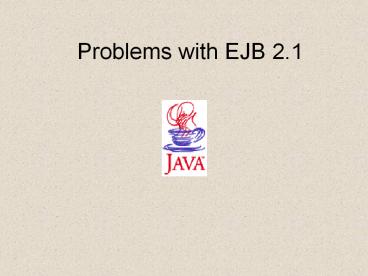Problems with EJB 2.1 - PowerPoint PPT Presentation
Title:
Problems with EJB 2.1
Description:
... (Cabin cabin); public Cabin findCabin ... import com.titan.domain.Cabin; _at_Stateless ... { return manager.find(Cabin.class, pKey); TravelAgentBean: The Bean Class ... – PowerPoint PPT presentation
Number of Views:109
Avg rating:3.0/5.0
Title: Problems with EJB 2.1
1
Problems with EJB 2.1
2
Deployment Descriptors
- Complex
- Multiple
- Partly vendor dependent
- Lack adequate defaults
- Better graphical tools needed
3
Verbosity
- Need two interfaces to specify one EJB.
- Remote and local interface
- Remote and local home interface
- Must implement special EJB classes.
- Numerous callback methods required.
- Even normally-empty callbacks like ejbPostCreate
must be specified
4
EJB Query Language
- EJB QL is currently weak.
- Strange object-oriented syntax
- Does not implement full SQL language
- Lacks functions and operations
- Programmers are forced to resort to JDBC and SQL.
- EJB 2.1 lacks vendor-independent
object-relational mapping tools.
5
Testing
- Entity beans are abstract classes.
- Consequently, they are completely untestable
outside the context of the container.
6
Whats Coming in EJB 3.0
EJB 3.0 Public Review Draft is on your CD (in
three parts). Proposed Final Review Draft due
to be approved in 2006.
7
Organization of the Specification Documents
- EJB 3.0 Simplified API
- EJB 3.0 Core Contracts and Requirements
- Java Persistence API
8
EJB 3.0 Overview
- Purpose is to reduce complexity of the EJB
architecture from the enterprise application
developers point of view. - Replace deployment descriptors with annotations
in the source code (like javadoc comments). - Specify defaults representing the expected
behaviors (configuration by exceptions). - Backward compatibility with EJB 2.1 (can mix and
match).
continued
9
EJB 3.0 Overview
continued
- Use of annotations to simplify JNDI lookup
mechanisms and environmental dependencies. - Simplification of enterprise bean types.
- Eliminate need for EJB component interfaces for
session beans. Use plain old Java objects (POJOs)
instead. - Eliminate need for home interfaces for session
beans.
10
EJB 3.0 Overview
continued
- Simplify entity bean persistence.
- Object-relational persistence API will work with
Hibernate, TopLink and JDO. - Eliminate all required interfaces for entities
written to the new persistence API. - Enhancement of EJB QL.
- Eliminate the requirement for the implementation
of callback interfaces. - Improve ability for testing outside the container
11
Acknowledgement
- The following slides are based on code that was
kindly provided by Bill Burke, Chief Architect at
JBoss. - It will appear in his new O'Reilly book
"Enterprise JavaBeans (Fifth Edition)".
12
Developing an Entity Bean
package com.titan.domain import
javax.persistence. _at_Entity _at_Table(name"CABIN")
public class Cabin implements
java.io.Serializable private int id
private String name private int deckLevel
private int shipId private int bedCount
_at_Id _at_Column(name"CABIN_ID") public
int getId() return id public void
setId(int pk) id pk
_at_Column(name"CABIN_NAME") public String
getName() return name
Cabin The Bean Class
continued
13
Developing an Entity Bean
continued
_at_Column(name"CABIN_NAME") public String
getName() return name public void
setName(String str) name str
_at_Column(name"CABIN_DECK_LEVEL") public int
getDeckLevel() return deckLevel public void
setDeckLevel(int level) deckLevel level
_at_Column(name"CABIN_SHIP_ID") public int
getShipId() return shipId public void
setShipId(int sid) shipId sid
_at_Column(name"CABIN_BED_COUNT") public int
getBedCount() return bedCount public void
setBedCount(int bed) bedCount bed
14
Developing an Entity Bean
- Annotations are objects, for example
- _at_javax.persistence.Entity specifes a persistent
entity managed by an EntityManager service. - _at_javax.persistence.Table specifies the database
table to map to. - _at_javax.persistence.Column defines a field in the
database table - _at_Id specifies the primary key of a row.
- Setters and getters are no longer abstract
methods as in EJB 2.1.
required
15
Developing an Entity Bean
- Entity bean is a POJO.
- Does not extend javax.ejb.EJBObject.
- Bean class implements Serializable, therefore
- Entity classes can be used as parameters and
return values. - Can be used as data transfer objects between
client and server. - Can be persisted in a database.
16
persistence.xml
ltpersistencegt ltpersistence-unitgt
ltnamegttitanlt/namegt ltjta-data-sourcegtjava/Defau
ltDSlt/jta-data-sourcegt lt/persistence-unitgt lt/pe
rsistencegt
17
Developing a Session Bean
package com.titan.travelagent import
javax.ejb.Remote import com.titan.domain.Cabin
_at_Remote public interface TravelAgentRemote
public void createCabin(Cabin cabin) public
Cabin findCabin(int id)
TravelAgentRemote The Remote Interface
18
Developing a Session Bean
package com.titan.travelagent import
javax.ejb.Stateless import javax.persistence.
import com.titan.domain.Cabin
_at_Stateless public class TravelAgentBean
implements TravelAgentRemote
_at_PersistenceContext(unitName"titan") private
EntityManager manager public void
createCabin(Cabin cabin)
manager.persist(cabin) public Cabin
findCabin(int pKey) return
manager.find(Cabin.class, pKey)
TravelAgentBean The Bean Class
19
Developing a Session Bean Annotations
- _at_javax.ejb.Remote as opposed to Local.
- _at_javax.ejb.Stateless as opposed to Stateful.
- _at_javax.persistence.PersistenceContext gives
access to the EntityManager.
20
CABIN Table in the Database
create table CABIN ( ID int primary key NOT
NULL, SHIP_ID int, BED_COUNT int,
NAME char(30), DECK_LEVEL int )
21
Creating a Client Application
package com.titan.clients import
com.titan.travelagent.TravelAgentRemote import
com.titan.domain.Cabin import
javax.naming. import java.util.Properties impor
t javax.rmi.PortableRemoteObject public class
Client_1 public static void main(String
args) try ontext jndiContext
new InitialContext() // use the jndi
properties file Object ref
jndiContext.lookup (TravelAgentRemote.class.ge
tName()) TravelAgentRemote dao (
TravelAgentRemote)PortableRemoteObject.na
rrow (ref,TravelAgentRemote.class)
continued
22
Creating a Client Application
continued
Cabin cabin_1 new Cabin()
cabin_1.setId(1) cabin_1.setName("Mast
er Suite") cabin_1.setDeckLevel(1)
cabin_1.setShipId(1)
cabin_1.setBedCount(3)
dao.createCabin(cabin_1) Cabin
cabin_2 dao.findCabin(1)
System.out.println(cabin_2.getName())
System.out.println(cabin_2.getDeckLevel())
System.out.println(cabin_2.getShipId())
System.out.println(cabin_2.getBedCount())
catch (javax.naming.NamingException
ne) ne.printStackTrace()
23
INSTALL.html
24
(No Transcript)
25
(No Transcript)
26
(No Transcript)
27
Coming May 1, 2006
Enterprise JavaBeans 3.0 by Bill Burke and
Richard Monson-Haefel, OReilly, ISBN 059600978X































